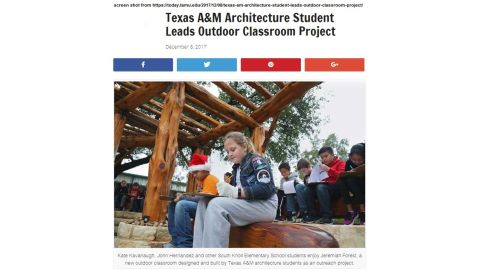
For the last two years, a group of Texas A&M undergraduate architecture students have been working on an outreach project for South Knoll Elementary School in College Station.
Jeremiah Forest, which is a 13,500 square foot outdoor classroom, will be dedicated Saturday afternoon.
Alex Santos led the project, which was built mainly with materials donated by local businesses and funding from the College of Architecture.
Jeremiah Forest was named for Santos’s brother, an Army corporal who died serving in Iraq.
Saturday’s dedication, which is open to the public, begins at 3 p.m.
Click below for comments from Alex Santos, visiting with WTAW’s Chelsea Reber.
Audio Player

News release from the Texas A&M college of architecture:
South Knoll Elementary School students in College Station can enjoy learning in Jeremiah Forest, an outdoor classroom, as a result of a two-year Texas A&M student outreach project led by Alex Santos, an undergraduate landscape architecture major.
The 13,500-square-foot classroom, named in honor of Santos’ brother, Jeremiah, a U.S. Army corporal who died serving in Iraq in 2006, will be dedicated at 3 p.m., Saturday, Dec. 9, at the school, located at 1220 Boswell St.
“I love the new space,” said Katina Osth, a fourth-grade math and science teacher who has already led math and reading activities in the new facility, which features a pergola-covered, amphitheater-style space, a large deck with tables and benches, and native Texas plants. “The sights and sounds of nature energize our students and it adds character and class to our school.”
The project, said Jorge Vanegas, dean of the College of Architecture, is the very definition of a high-impact learning experience because students applied their knowledge to design and build the classroom.
“Although they had access to faculty expertise, this was a totally student-run project,” he said.
The volunteer project began October 2015, when South Knoll administrators and then-PTO president Mandy Pryor, looking to add an outdoor learning area to the school’s campus, contacted Eric Bardenhagen, assistant professor in the Department of Landscape Architecture and Urban Planning.
Bardenhagen then approached Santos, head of the Texas A&M student chapter of the American Society of Landscape Architects and his own design-build firm, Vantos Landcaping. Santos led the project while pursuing his degree and running his business.
After selecting a final design created through a collaborative effort with fellow landscape architecture students and the school, Santos led a small army of local building supply vendors, financial donors, the South Knoll Parent-Teacher Organization, students from both the elementary school and the university, and more than 100 community volunteers to finance and build the ambitious project.
Once he secured the donation of a granite monument on the site with space for donors’ names and a project synopsis, the list of donors quickly began to grow.
“Because it was a chance for vendors, students and community members to be part of something cool and permanent, it was easy to get donations and motivate volunteer builders,” Santos said. “The Texas A&M students wanted to be part of a real project.”
He said the deck, funded by the College of Architecture, the pergola, and additional classroom elements were built using an “old-fashioned” notch and groove process. Components of the classroom were fabricated at the College of Architecture’s woodshop and College Station ISD facilities.
“The pergola was made with 12-by-12 cedar posts,” said Santos, who hand-cut each post notch-by-notch and groove-by-groove.
Volunteers stripped, sanded and sealed each post.
“It’s built stronger than most houses,” he said. “Every single bracket and bolt in the project was custom made.”
The design and construction methods were chosen to maximize the classroom’s longevity, said Santos.
“It will be about 100 years before you see any degradation of the facility,” Santos said. “It’s going to be there for a very long time.”
Participants from a wide variety of student organizations in the College of Architecture, including the American Society of Landscape Architects, American Institute of Architecture Students, the Student Health Environments Association, and the Design-Build Institute of America all contributed to the project.
